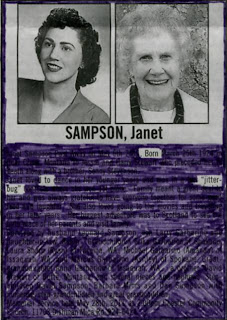
I just finished reading
The Book as Art by Krystyna Wasserman, which showcases the exhibit by the same name put on by the
National Museum of Women in the Arts. If you are at all interested in Artist's Books, this is a must read. As regular readers know, I've been working on understanding this particular art form for awhile, and feel I am finally getting a handle on it. This book certainly helped.

One artist's book in particular spoke to me on several levels. Connie Conner Blair's
"She has vanished from the outside and gone within..." is fairly traditional in form, and uses things I understand like ink, oil paint sticks, collage and etching. Each spread is a different color family, the left side being mostly mottled, the right side striated. Beautiful symmetry to hold the story she unfolds.
It is the text, though, that first caught my attention and made me take a closer look. I find it most unnerving to see, coming from someone else's hand, words I could have written myself. I was haunted enough by the few lines displayed that I spent time tracking down the full text - not all of which applies to my own history but much that does. That bit about "
...books she doesn't read and things she doesn't need. She owns dishes enough for eight yet no one ever comes to dinner." Yeah, that struck a nerve. You can view this artist's book and several more in their entirety
here.

















































